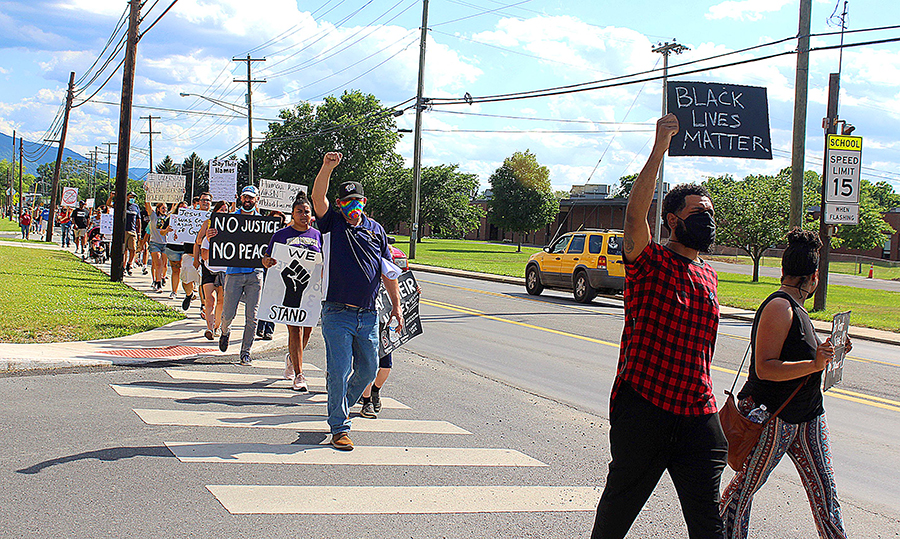Aija Burnette, a 17-year-old rising senior at East Hardy High School, saw the cell phone video of George Floyd’s death in Minneapolis, and decided she’d had enough.
She talked to her boyfriend and her friends, including Alivia Sager and Skyler Landacre, both 17 and classmates, and Taylor Strawderman, a 15-year-old rising sophomore. Instead of dismissing her thoughts, they cheered her on.
First there was a Facebook page. Burnette worried about putting herself ‘out there’ on social media. She thought there would be hate.
“We’re trying to have a really safe space,” Burnette said, explaining her intentions behind creating the site.
Burnette hasn’t always felt safe in Hardy County.
She recalled being 5 years old, and playing on a school playground. An older boy pushed her over.
A teacher told Burnette that because she hadn’t seen it happen and saw no evidence, the teacher couldn’t do anything about it.[private]
Burnette still remembers the cuts and scrapes she had.
She remembers in middle school, other kids would make fun of her skin.
“They said the color of my skin looks like poop,” she said.
And throughout it all, other students called her the N-word.
She told teachers, and school administrators. They told her they would take care of it, but Burnette rarely saw changes until or unless other students directly witnessed what happened.
Burnette had experience behind her concern for how people would react to the Facebook page she and her friends created.
But as more people joined, and invited other people to the ‘“I CANT BREATHE” Hardy County’ page, what she got was support, and ideas.
Mostly.
Ideas flew as quickly as people joined, but Burnette, Sager, Landacre and Strawderman decided to do a candlelight vigil, first. The date and time changed several times, but their intention for peaceful event never wavered.
It happened, but without several of the youth because threats came to light the day of the vigil.
Facebook posts from a different page revealed a group discussing the students’ names and where they lived, whether or not they were 18, and marking Burnette as a “import from Fairfax.”
A poster named Jeremy wrote, “This is our county, not theirs. Have people set up in different locations if they’re going to be on the move, out of site, with a scope ready to take out anyone that tries to set fires, or destroy the town’s or someone’s personal property. Alum bank (sic) would a great spot to be on if someone is a good shot lol.”
The West Virginia State Police, Hardy County Sheriffs Office and the Moorefield Police Department all received multiple calls regarding the posts.
The posts also led the student planners to make their Facebook page private, and created suspicion regarding their plans and notifying authorities.
By mid-afternoon on Monday, June 8, the teens got the word out the vigil would be that night at 7:30.
A Peaceful Vigil
People began showing up at the Hardy County Public Library about 7:20 p.m. Most wore masks, and about half carried signs. Someone brought a cooler. Others brought hand sanitizer and speakers for music.
A pick-up rolled by, the passenger leaning out to yell something mostly indistinguishable, except for an obscenity.
A protester called back, “Jesus loves you!”
When the sidewalk became too crowded, the group crossed over to the open parking area next to the McMechen House.
People continued arriving for about an hour; at its peak, the vigil included approximately 40 people. Most identified as white, and while many were young, there were several who were middle-aged.
They carried home-made signs. Some bore the names of men, women and children who had died during interactions with police. Others included slogans, Bible verses, and hashtags from social media.
Some drivers passed repeatedly, Confederate battle flags on their vehicles. Some blasted country music through open windows.
One driver became so upset about the vigil, she drove off even though her light was still red.
“Did that just happen?” asked one of the protesters.
Other drivers and passengers cheered or honked their horns in support, sometimes extending a fist in support.
Moorefield Police stayed across Winchester Avenue in another parking lot, standing by. They were there to protect the protesters, because of the Facebook posts.
The Hardy County Sheriffs Office drone hovered overhead, checking rooftops and looking for trouble that, fortunately, never appeared.
Those present attended for different reasons, including support for black friends and concerns about police brutality in general. No one interviewed admitted experiencing violence from law enforcement in Hardy County.
“I do believe police violence is a systemic problem,” said Elizabeth Ludecker, 26. “If you keep getting bad apples from a tree, you start to wonder if it’s a problem with the roots.”
“I’m ready for ‘All Lives Matter’ to mean what it actually says,” said Muryssa George, a 2015 graduate of Moorefield High School and graduate from West Virginia University.
“I want to use my voice for those who can’t,” George said.
As part of the vigil, Carson Crawford led attendees in a Christian service of lament shared through social media.
Crawford is a 2016 Moorefield High School graduate and a 2020 graduate from Davis & Elkins.
Near the end of the service, participants observed eight minutes and 46 seconds of silence, representing the time a police officer’s knee held down George Floyd. Everyone either knelt or lay face-down with their hands behind their backs, as though handcuffed.
Horns, cheers, and curses continued from vehicles passing by. The drone buzzed overhead, and police calmly observed.
The vigil formally ended about 9 p.m. Many attendees stopped to thank the police for their presence as they left.
Protest March
Like the vigil, the protest march time and date changed several times, but planners’ intention for it to be peaceful never did.
Empowered by the success of the vigil, even more people met in the same parking lot at 4 p.m. on Friday, June 12.
Nearly 75 people gathered. Crawford’s voice carried easily over the group: “We invite you to join us as we peacefully — peacefully — protest.”
The march proceeded north on Main Street, and kept to the sidewalk; they turned east on Spring Avenue and into the Town Park. Police presence was heavy, as social media posts raised concern about violence from both sides.
Throughout the week, posts spread rumors about busloads of protesters coming into Moorefield from other places. Main Street property owners were worried about destruction and vandalism. Protesters marching were worried about being attacked.
All four student planners attended and marched, determined to see their idea become real.
Once again, passing traffic weighed more heavily towards support, with cheers and honking horns dominating. People joined the march along the route, carrying their own signs and adding their voices.
Some along the route held different signs. A pick-up parked at the VFW had two men and a young boy on the tailgate. A Confederate battle flag in the shape of the Punisher skull was centered on the back window, and an American flag was propped in the back.
One of the men held a sign that read, “Every Life Matters. No Matter The Skin Color. Two Wrongs Don’t Make A Right!”
Others along the route stood by to protect businesses or other property.
“I was told by the police that these instigators were from the city and Wardensville,” said Tom Denney, who stood in front of a shop near the intersection of Main Street and Spring Avenue. “If that is true, they need to stay there.
“As I see it, all this does is cause trouble,” Denney continued. “Demonstrations seem to lead to riots in many cases. So what I think is, these people, mostly kids, don’t have a clue what’s going on in this world, and they should have been at work. Bring back the draft and they will get all the race relations they need.”
Police positioned themselves along the route, ensuring both property protection and observer and protester safety. For most of the route an officer walked nearby. The drone appeared again, buzzing overhead, scanning for any sign of any trouble.
There was none, beyond a few traded insults.
At the Park, protesters gathered at the shelter attached to the barbecue pit. Water and Gatorade were offered, and all were offered the chance to speak.
“We’re here for peace. We’re here for love. And we’re exemplifying that,” said Christopher Claudio.
Drake Sunryder recalled realizing, growing up in urban Florida, that when he was with white friends, they were never stopped by police. But when he walked with black friends, they often were.
“I thought, so long as I wasn’t contributing to the problem, I wasn’t part of the problem,” he said, becoming emotional.
“In my junior year of high school, someone threatened to hang me,” said Malik Landes, adding that while he often felt he didn’t belong while growing up, “I feel like I have a place, here.”
“Educate your friends in love,” said Brian Bucklew.
Nancy Yates said, “Vote. And vote with your money. Make sure that business supports Black Lives Matter. Put (your money) where it will serve your community.”
“It’s definitely learned,” said Leslie Williams, relaying an anecdote about a word a white child used towards her child on a playground. An older woman quickly corrected the child, and apologized profusely to Williams.
“The grandmother got it,” she said. “But I couldn’t help think where the kid learned the word.”
Williams also had thoughts for Black Lives Matter supporters.
“Take advantage of who you are, to teach those like you. People are gonna hate us, collectively. But one-on-one, you talk to someone behind closed doors, and they might hear you.
“If you have kids,” she said, “Teach them now, how to act (with black children).”
“It starts at home,” agreed Stacie Thompson.
The Moorefield police officers kept their distance, respectful and avoiding intimidation while still able to react if a threat arose.
Crawford led the prayer service again at the Park, and again, led the group in 8:46 of silence and reflection.
The sound of traffic was distant in the shelter, and the silence was dominated by the sound of wind through the trees, a family on the playground, and the drone, buzzing overhead.
About half the protesters left at that point, but the other half marched back to the stoplight. Traffic was lighter, and all of those who’d stood along the route were gone.
People peeled off the group, so that by the time they got to the stoplight, only about 30 people were left, hot, tired and elated.
“This is not a one-off,” Claudio said.
Burnette, Sager, Strawderman and Landacre thanked those who were left, and reiterated that there would be other events: “This is a movement, not a moment.”
“This is about unity,” Burnette said. “This is about equality.”[/private]

